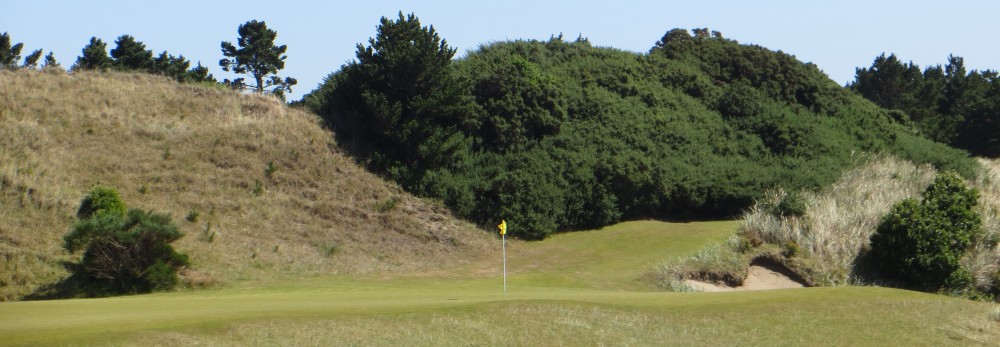 If you are in the vicinity of Carlsbad, California there is a golf destination about 10 miles north, in the surf town of Oceanside, that you should go out of your way to experience.
If you are in the vicinity of Carlsbad, California there is a golf destination about 10 miles north, in the surf town of Oceanside, that you should go out of your way to experience.
Goat Hill Park has a golf vibe that all municipal golf courses should strive for, including affordable rates, full featured practice facilities, their three-hole “Playground” approach and putt course for kids that actually grows the game, and a unique 18-hole Par 65 executive course that will test your golf skill set and stimulate your senses with panoramic views of the hills of Oceanside and the Pacific Ocean.
Over the years the facility struggled financially and there have been repeated attempts by developers to consume this property for just another commercial or residential development. But the locals have had to foresight to fend them off and a recent revitalization project spearheaded by John Ashworth brought Goat Hill facilities and amenities up to World Class but kept the spirit of the operation in tact to serve the Working Class as their motto indicates. The result is now a thriving and affordable community resource that all can enjoy on a regular basis.

The community anointed the name Goat Hill because of the severity of the land Ludwig Keehn had to use to morph an old 9-hole course into an 18-Hole Par 65 short course in the early 1990’s. General public weekday rates are $42 to walk-$58 to ride and considerably less for members, local residents, and seniors. Kids can walk for $10 and ride for $17.

Inside the modest golf shop fit for the working class clientele, you are greeted with all sorts of nostalgic memorabilia including pictures of celebrities like Bill Murray, Adam Scott, Kelly Slater, and others who have frequented this place. There is also an ample selection of domestic and regional beer at surprisingly affordable prices.

The annual Wishbone Brawl Tournament has attracted some pretty well known professionals to participate….many who live in southern California drop in from time to time to refresh their golf batteries.

There is a weekly Friday afternoon Skins Games that is a hotbed for locals as well as an array of other robustly attended competitions run through the year. They have a vibrant junior golf program, a women’s league, and even disc golf for those with that apptitude.


A section of the matted driving range bays feature Foresight Game Improvement Technology but as you can see it is not a Starbuck’s crowd that is hanging about this place.

Folks of all ages and backgrounds make use of these practice facilities, some bring along their furry support staff to dutifully oversee their practice sessions. This one is clearly channeling her inner Sean Foley.

There are three putting greens about. One large enough for full-fledged short game practice, a second for remedial putting work, and one next to the first tee for a last minute warm up before the round.

To me the centerpiece of Goat Hill Park is “The Playground”, a three-hole Approach and Putt Course suited for kids (who play for free) or for anyone new to the sport who wants to develop their game. The Playground has short grass everywhere with sculpted green complexes sprawling across rolling contours…..it is mezzanine golf….actual golf between the range and the course.


In the middle of the afternoon you can see hordes of youngins chirping and frolicking about in a real party atmosphere that encourages exploration, experimentation, and refinement of their developing golf skills….or simply having fun.


Then there is the real course, a hilly, rambling roller-coaster affair. 8 Par 3’s, 9 hybrid Par 4’s, and 1 not so Par 5 with kitschy names will test you, taunt you, and eventually give you a few reasons to come back again. Multiple sets of tees for folks of varying ability and a special forward tee that makes up the “Mini-Goat”…..an approach and putt derivation for those who find the many uphill holes a mountain too high to climb.



There is good grass where it matters and no grass where it does not (which saves on maintenance and makes finding an errant shot pretty easy). Plenty of forced carries off the tee and well protected small turtle back greens on the other end. It is like there was a yard sale at a used VW dealership and they simply buried 14 old Beetles and grassed them over. Holding an approach pitch or simply two-putting is a real challenge on The Goat.


Precipice green settings just about everywhere. Besides negotiating elevation changes that will defy the slope adjustment setting on your Bushnell, there is virtually no bail out spot on most of them. Hit it where you are aiming or play the next one from the oblivion. Those who have any sense will play a match with a buddy and forget keeping a medal score. But you have to admit the horizon views are breathtaking.


“Oz”, the finishing hole on the outward half, speaks volumes to what Goat Hill Park is all about. Simple 100-yard pitch into an amphitheater green complex is a birdie chance a lurkin’. Note the plethora of homemade viewing benches that adorn the surrounding hills to provide ample seating for adoring crowds of people and dogs for the big events.

Goat Hill Park is a must visit for anyone with a serious golf bucket list. You will walk away from this experience with a dented ego but a head full of good vibes from this very unique golf destination.
February, 2023

















